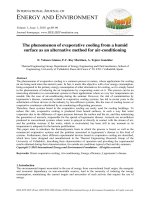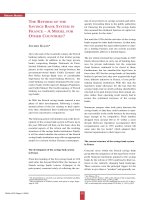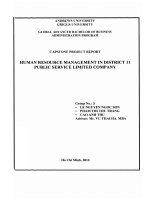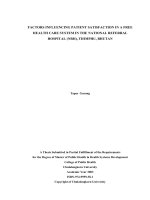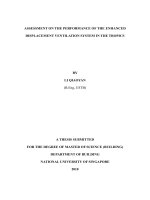Ice slurry storage system in district cooling application for air conditioning
Bạn đang xem bản rút gọn của tài liệu. Xem và tải ngay bản đầy đủ của tài liệu tại đây (4.78 MB, 157 trang )
ICE SLURRY STORAGE SYSTEM IN DISTRICT
COOLING APPLICATIONS FOR AIRCONDITIONING
By
MOHAMMAD KAMAL HOSSAIN
B.Sc. (Eng.) (BUET, Bangladesh)
A THESIS SUBMITTED
FOR THE DEGREE OF MASTER OF ENGINEERING
DEPERTMENT OF MECHANICAL ENGINEERING
NATIONAL UNIVERSITY OF SINGAPORE
2004
ACKNOWLEDGEMENT
The author would like to express his sincere appreciation, gratitude and heartiest
thanks to his supervisors Associate Professor M.N.A. Hawlader and Professor N.E.
Wijeysundera for their encouragement and invaluable guidance during the pursuit of
this research work. Their invaluable advice and constructive criticism have been
always enlightening and inspiring.
The author wishes to express his special thanks to the technical staffs of both Thermal
process Lab.1 and Energy Conversion Laboratories, specially Mr. Yeo Ho, Mr. Y.L
Chew, Mr. Tan and Mr. Anwar Sadat for their assistance during the fabrication of
experimental set-up.
The author expresses his special thanks to Dr Md. Raisul Islam, Jahangeer S/O K.
Abdul Halim and to all his friends who have helped in one way or another to make his
life most enjoyable and provided inspiration for the completion of the project.
The author is greatly indebted to The National University of Singapore for providing
financial support, which enabled him to carry out this study.
Finally, the author also extends his heartfelt and deepest gratitude and appreciation to
his family members for their invaluable inspiration, support, and encouragement
rendered towards his developments in education.
Above all, author expresses his deep thanks and profound gratitude to the Almighty,
for enabling him to achieve this end.
i
Table of Contents
TABLE OF CONTENTS
Page
ACKNOWLEDGEMENTS
i
TABLE OF CONTENTS
ii
SUMMARY
vi
NOMENCLATURE
ix
LIST OF FIGURES
xiii
LIST TO TABLES
xix
CHAPTER 1 INTRODUCTION
1
1.1 Conventional Ice Storage System
2
1.2 Advantages of Ice Slurry Storage System
3
1.3 Objectives of Research
4
1.4 The Scope
4
CHAPTER 2 LITERATURE REVIEW
2.1 Different Method of Ice Slurry production, Modeling
6
6
and Design Aspects
2.2 Ice Slurry Flow Heat Transfer and Characteristics
11
2.3 Advantages and Cost Savings Resulting from use of the
14
Ice Slurry System
CHAPTER 3 THE EXPERIMENTS
3.1 Description of the Setup
19
19
3.1.1 Water Tank/Glass Column
21
3.1.2 Coolant Path
21
3.1.3 Centrifugal Pump and Flow Meter
22
3.1.4 Shell and Tube Heat Exchanger
22
Ice Slurry Storage System in District Cooling Application for Air-conditioning
ii
Table of Contents
3.1.5 Progressive cavity pump
25
3.1.6 Cooling coil, secondary refrigerant, and the cold bath
26
3.2 Instrumentation
27
3.3 Direct Contact Heat Transfer Method
28
3.3.1 Mode of Operation
28
3.3.1.1 Nozzle at the top: Shower spray
29
3.3.1.2 Nozzle at the top: Fountain spray
30
3.3.1.3 Injection from bottom
32
3.3.1.4 Test procedure
33
3.3.2 Estimation of the drop size
34
3.3.3 Estimation of residence time
38
3.4 Freezing of Binary Solution
42
3.5 Accuracy of Measurments
44
CHAPTER 4 MATHEMATICAL MODEL FORMULAITON
45
4.1 Physical Arrangement of Direct Contact Method
45
4.1.1 Model for FC-84 system
46
4.1.1.1 Sensible cooling of water
48
4.1.1.2 Ice-Slurry formation
50
4.2 Physical Arrangement of Binary Solution Flow
4.2.1 Model for binary solution
52
52
4.2.1.1 Determination of freezing point temperature
53
4.2.1.2 Governing equation for slurry generation
54
using ethylene glycol
4.2.1.3 Solution procedure
4.3 Energy Extraction for Space Cooling Purpose
58
60
4.3.1 Energy withdrawal analysis
60
4.3.2 Ice slurry properties
63
Ice Slurry Storage System in District Cooling Application for Air-conditioning
iii
Table of Contents
CHAPTER 5 RESULTS AND DISCUSSION
5.1 Direct Contact Heat Transfer Using for FC-84
64
64
5.1.1 Experimental Results
64
5.1.2 Comparison of experimental and predicted results
67
5.1.2.1 Nozzle operation at shower spray mode
67
5.1.2.2 Nozzle operation at fountain spray mode
72
5.1.2.3 Spray from bottom
76
5.1.3 Parametric Study
82
5.1.3.1 Effect of coolant flow rate
83
5.1.3.2 Influence of nozzle diameter
85
5.2 Method Using Freezing of Binary solutions
87
5.2.1 Effect of flow rate
88
5.2.2 Effect of mole fraction on freezing point depression
91
5.3 Energy Recovery from Ice Slurry
93
5.3.1 Effect of flow rate on OHTC and cooling duty
94
5.3.2 Comparison of experimental and predicted results
96
CHAPTER 6 CONCLULSIONS
101
RECOMMENDATIONS
103
REFFERENCES
104
APPENDIX A
CALIBRATION OF GRAPH & INSTUMENTS
113
APPENDIX B
TABULATED RESULTS
122
Ice Slurry Storage System in District Cooling Application for Air-conditioning
iv
Table of Contents
APPENDIX C
ERROR ANALYSIS
126
APPENDIX D
GENERAL SOLUTIONS
131
APPENDIX E
DETERMINATION OF FREEZING POINT OF A
135
BINARY SOLUTION INTO A BEAKER
Ice Slurry Storage System in District Cooling Application for Air-conditioning
v
Summary
SUMMARY
In Singapore, more than 50 percent of typical buildings energy usage relates to the
Heating, Ventilating, and Air-conditioning (HVAC) and chiller plant. The reduction of
energy consumption is the key issue for overall energy conservation in Singapore. An
attempt was made in the present study to develop an ice slurry system by using the
lower tariff available at night to support peak load during the day. This leads to a
reduction in size of the system and obviously lower cost. In this study, an ice slurry
storage system was designed and its performance was evaluated under different
operating conditions. A successful development of an efficient ice slurry storage
system would be useful for applications in domestic and industrial air-conditioning
systems. In this project, the potential of using ice slurry storage system for domestic
and industrial applications was investigated.
The system tested was comprised of five major components assisted by some auxiliary
devices. The main components were cold bath, glass column that acts as an evaporator,
progressive displacement screw pump, a shell and tube heat exchanger, and injection
nozzle for coolant. Three different nozzles/arrangements were used for the production
of ice slurry depending on the mode of operation. Nozzles were located at the top and
bottom of the test section. The nozzle at the top was operated in both shower spray and
fountain spray modes. The nozzle at the bottom sprayed coolant vertically up. A data
acquisition system was used to record and monitor the parameters required for the
evaluation of the system performance. A series of experiments was performed to
evaluate the performance of the system with a new refrigerant, Fluorinert FC-84, for
the production of ice slurry using direct contact heat transfer and compared with the
ethylene glycol. Experiments were conducted using different nozzles to observe the
Ice Slurry Storage System in District Cooling Application for Air-conditioning
vi
Summary
influence on ice slurry production. It was found that, for the shower spray nozzle
assembly, clogging of nozzle and ice sinking down towards the bottom was more
severe than that for the fountain spray nozzle assembly. It was also found that, for the
fountain spray pattern, nozzle with diameter 6mm and flow rate 6 l/min gave the best
results. On the other hand, nozzle assembly located at the bottom of the glass column
minimized the nozzle clogging and ice sinking problem. Ice packing factor (IPF) was
up to 50% for the nozzle assembly at the bottom. Nozzle diameter used for injection
from bottom was 3 mm.
A mathematical model has been developed and presented for the system. Based on the
model, a simulation program was developed to predict the thermal performance of the
system using Compaq Visual Fortran. These results were compared with those
obtained from the experiments and good agreement was found. For shower and
fountain spray pattern nozzle assembly, the heat transfer coefficients between the
coolant droplet and water were found to be 4250 W/m2 K and 4875 W/m2 K for the
flow rate of 4 l/min and 6 l/min, respectively. The heat transfer coefficients for the
nozzle assembly at the bottom of the glass column were found to be 5310 W/m2 K and
5800 W/m2 K for the flow rate of 8 l/min and 10 l/min, respectively.
Ice slurry generation using the ethylene glycol was also carried out. The variation of
the binary solution temperature was found both experimentally and analytically. The
experimental results found from the freezing of binary solutions were compared with
the predicted results and a good agreement was found. The effects of the glycol mole
fraction on the ice formation were studied using the model developed for the
evaluation of freezing point depression. It was found that the mole fraction the glycol
Ice Slurry Storage System in District Cooling Application for Air-conditioning
vii
Summary
increased the increase of ice formation. It was also found that, as the ice formation
increased, mole fraction of glycol also increased, which affected the freezing point of
ice. A change in the freezing point temperature from -20 C to -50 C was found for a
change in the mole fraction from 0.025 to 0.045 of glycol.
To recover energy from the ice slurry, a shell and tube heat exchanger was used. A
progressive displacement screw pump was used for pumping the ice slurry through the
heat exchanger. A series of experiments was performed for the evaluation of the
thermal performance of the energy withdrawal process. The flow rate of the cooling
medium was varied in the range of 8-16 l/min, whereas the ice slurry flow rate changes
were 8-12 l/min. The performance of the heat exchanger was found to be strongly
dependent upon both the cooling medium flow rate and ice slurry flow rate. Overall
heat transfer coefficients for the extraction of energy from the ice slurry were found to
be 1.40 kW/m2 K, 1.2 kW/m2K and 1.10 kW/m2K for flow rates of 12 l/min, 10 l/min
and 8 l/min, respectively. The heat transfer capacity of the shell and tube heat
exchanger was found to increase more than (35-40%) when compared with the singlephase fluid i.e. chill water only.
Ice Slurry Storage System in District Cooling Application for Air-conditioning
viii
Nomenclature
NOMENCLATURE
Symbol
DESCRIPTION
UNIT (SI)
ad
Area of a drop
m2
A
Surface area of the tube
m2
Ao
Area of heat gain
m2
As
Bundle cross flow area
m2
c
Specific heat capacity
Jkg −1 K −1
cc
Specific heat of drop
Jkg −1 K −1
cices
Specific heat capacity of ice slurry
Jkg −1 K −1
cw
Specific heat capacity of cooling water
Jkg −1 K −1
Cg
Specific heat of glycol
kJ/kg K
Cw
Specific heat of water
kJ/kg K
dd
Mean diameter of drops
m
do
Outer meter of tube
m
De
Equivalent diameter
m
ρw
Density of water
kg/m3
ρice
Density of ice
kg/m3
hd
Heat transfer coefficient of drop
hi
Enthalpy of ice
Hf
Latent heat of fusion of ice
Hif
Molar heat of enthalpy
kJ/Kmol
ho
Outside heat transfer coefficient
W/m2K
k
Thermal conductivity
W/mK
Wm −2 K −1
kJ/kgK
Jkg −1
Ice Slurry Storage System in District Cooling Application for Air-conditioning
ix
Nomenclature
kw
Thermal conductivity of water
W/mK
LMTD
Log Mean Temperature difference
m& c
Mass flow rate of coolant
kgs −1 .
m& ices
Mass flow rate of ice slurry
kgs −1 .
m& w
Mass flow rate of water
kgs −1 .
M
Mass
Mw
Molecular weight of water
Mg
Molecular weight of ethylene glycol, Mw
Nd
Rate of generation of drops at nozzle
NuD
Nusselt number
Pr
Prandtl number
PT
Pitch
m
qd
Heat absorbed by drop
J
Q
Average heat transfer rate
J/s
Qcw
Heat transfer from cooling water to ice slurry
J/s
Qices
Heat transfer from ice slurry to cooling water
J/s
R
Molar (Universal) gas constant, 8.3145
Re D
Reynolds number
T
Temperature
K
Tcw. in
Inlet cooling water temperature
K
Tfo
Freezing temperature of solution
K
kg
kg/kmol
kg/kmol
s −1
kJ/kmol K
Ice Slurry Storage System in District Cooling Application for Air-conditioning
x
Nomenclature
Ts
Solution temperature
K
Tice.in
Ice slurry water inlet temperature
K
Tice.out
Ice slurry water outlet temperature
K
Tcw.in
Cooling water inlet temperature
K
Tcw.out
Cooling water outlet temperature
K
U
Overall heat transfer coefficient of
Wm −2 K −1
heat exchanger
Wm −2 K −1
Uo
Overall heat transfer coefficient
vd
volume of drop
m3
Vg
Volume of ethylene glycol
m3
Vw
Volume of water
m3
Xi
Ice concentration
Xw
Mole fraction of water
Greek symbols
ρc
Density of coolant
kgm −3
ρis
Density of ice slurry
kgm −3
ρi
Density of ice
kgm −3
τr
Residence time
λ
Parameter
Ice Slurry Storage System in District Cooling Application for Air-conditioning
s
xi
Nomenclature
λi
Thermal conductivity of ice
W/mK
λis
Thermal conductivity of ice slurry
W/mK
ε
Ice fraction
µb
Viscosity of liquid
N-s/m2
µis
Viscosity of ice slurry
N-s/m2
µw
Viscosity of water
N-s/m2
φi
Fraction of ice slurry
Subscripts
b
bulk
c
coolant
d
drop
g
glass and glycol
i
ice
is
ice slurry
w
water
i
drop at inlet
o
drop at outlet
Ice Slurry Storage System in District Cooling Application for Air-conditioning
xii
List of Figures
Figure
Name of Figure
Page
Figure 1.1 Schematic diagram of a conventional ice storage system
3
Figure 3.1 Schematic diagram of the set-up
20
Figure 3.2 A photograph of the experimental set-up
20
Figure 3.3A photograph of glass tank
21
Figure 3.4 A photograph of insulated glass tank
21
Figure 3.5 A photograph of centrifugal pump
22
Figure 3.6 Flow meter
22
Figure 3.7 A photograph of shell and tube heat exchanger
23
Figure 3.8 Photograph of the positive displacement screw pump
25
Figure 3.9 A photograph of the cooling coil and cold bath
26
Figure 3.10 Shower sray nozzle assembly
30
(a) Photograph of shower nozzle
29
(b) Shower flow pattern
30
(c) Drop generation
30
Figure 3.11 Fountain spray nozzle assembly
31
(a) Photograph of fountain nozzle
31
(b) Fountain nozzle design
31
(c) Fountain spray nozzle
31
(d) Fountain flow pattern
31
(e) Dropdistribution
31
Figure 3.12 Nozzle assembly at the botttom of the tank
32
(a) & (b) PVC Nozzle
(c) Copper tube nozzle at the bottom
49
49
(d) Droplet generation
Figure 3.13 Frequency distribution of drop diameter for flow rate of
50
35
4 l/min; (Fountain spray nozzle, diameter 6 mm
Ice Slurry Storage System in District Cooling Application for Air-conditioning
xiii
List of Figures
Figure 3.14 Frequency distribution of drop diameter for flow rate of
35
6 l/min; (Fountain spray nozzle, diameter 6 mm)
Figure 3.15 Frequency distribution of drop diameter for flow rate of
36
4 l/min; (Shower spray nozzle, diameter 6 mm)
Figure 3.16 Frequency distribution of drop diameter for flow rate of
37
6 l/min; (Shower spray nozzle, diameter 6 mm)
Figure 3.17 Frequency distribution of drop diameter for flow rate of 8 l/min;
37
(Nozzle at bottom, diameter 3mm)
Figure 3.18 Frequency distribution of drop diameter for flow rate of 10 l/min;
38
(Nozzle at bottom, diameter 3mm)
Figure 3.19 Frequency distribution of droplet residence time for flow rate of
39
4 l/min; (Fountain spray nozzle, diameter 6 mm)
Figure 3.20 Frequency distribution of droplet residence time for flow
39
rate of 6 l/min;(Fountain spray nozzle, diameter 6 mm)
Figure 3.21 Frequency distribution of droplet residence time for flow rate of
40
4 l/min;(Shower spray nozzle, diameter 6 mm)
Figure 3.22 Frequency distribution of droplet residence time for flow rate of
41
6 l/min;(Shower spray nozzle, diameter 6 mm)
Figure 3.23 Frequency distribution of droplet residence time for flow
41
rate of 8 l/min; (Nozzle at bottom, diameter 3mm)
Figure 3.24 Frequency distribution of droplet residence time for flow rate of
42
10 l/min; (Nozzle at bottom, diameter 3mm)
Figure 3.25 Flow circuit of the binary solution
43
Figure 4.1 Nozzle is located above water surface; shower type spray nozzle
47
Figure 3.2 Nozzle is located inside the water surface; fountain
47
type spray nozzle
Figure 4.3 Nozzle is located inside the coolant; coolant sprayed
47
vertically upward
Figure 3.4 Flow chart for of coolant and water temperature profile
Ice Slurry Storage System in District Cooling Application for Air-conditioning
51
xiv
List of Figures
Figure 4.5 A cold bath showing the 50% glycol water solution and
52
cooling coil
Figure 4.6 Diagram for the energy balance inside the tube during ice formation
54
Figure 4.7 Overall resistances for tube
55
Figure 4.8 Flow chart for calculation of the solution temperature, mole
59
fraction of water and ice formation rate
Figure 5.1 Variation of water temperature with time (Shower spray nozzle,
65
diameter 6 mm)
Figure 5.2 Variation of water temperature with time (Fountain spray nozzle,
66
Diameter 6 mm)
Figure 5.3 Variation of water temperature with time (Nozzle at bottom,
67
diameter 3mm)
Figure 5.4 Comparison between predicted and experimental temperature
68
with time (nozzle diameter: 4 mm; flow -rate 4 l/min)
Figure 5.5 Comparison between predicted and experimental temperature
68
with time (nozzle diameter: 4 mm; flow-rate 6 l/min)
Figure 5.6 (a) Ice Agglomeration wth Shower Spray Nozzle
69
Figure 5.6 (b) Agglomerated ice
68
Figure 5.7 Comparison between predicted and experimental temperature
70
with time (nozzle diameter: 6 mm; flow- rate 4 l/min)
Figure 5.8 Comparison between predicted and experimental temperature
71
with time (nozzle diameter: 6 mm, flow -rate 6l/min)
Figure 5.9 Comparison between predicted and experimental temperature
73
with time (nozzle diameter: 4 mm; flow- rate 4 l/min
Figure 5.10 Comparison between predicted and experimental temperature
73
with time (nozzle diameter: 4 mm; flow- rate 6 l/min)
Ice Slurry Storage System in District Cooling Application for Air-conditioning
xv
List of Figures
Figure 5.11 (a) Ice Slurry Formation with Fountain Spray Nozzle
74
Figure 5.11 (b) Ice Slurry
74
Figure 5.12 Comparison between predicted and experimental temperature
74
with time (nozzle diameter: 6 mm; flow- rate 4 l/min)
Figure 5.13 Comparison between predicted and experimental temperature
75
with time (nozzle diameter: 6 mm; flow- rate 6 l/min)
Figure 5.14 Comparison between predicted and experimental temperature
76
with time (nozzle diameter: 3 mm; flow- rate 8 l/min)
Figure 5.15 Comparison between predicted and experimental temperature
77
with time (nozzle diameter: 3 mm; flow- rate 10 l/min)
Figure 5.16 Variation of total ice formation time with flow rate
83
of coolant
Figure 5.17 Variation of total ice formation time with the flow rate of coolant
84
Figure 5.18 Variation of total ice formation time with the flow rate of coolant
84
Figure 5.19 Effect of nozzle diameter on ice formation for flow rate
86
6 l/min (shower spray)
Figure 5.20 Effect of nozzle diameter on ice formation for flow rate
86
6 l/min (Fountain spray)
Figure 5.21 Effect of nozzle diameter on ice formation for the flow
87
rate 8 l/min (Nozzle at bottom)
Figure 5.22 Variation of binary solution temperature through the cold bath
88
for the flow rate of 10 l/min, 15 l/min and 18 l/min.)
Figure 5.23 Comparison between predicted and experimental solution
89
temperature with distance (flow rate 10 l/min)
Figure 5.24 Comparison between predicted and experimental solution
90
temperature with distance (flow rate 15 l/min)
Figure 5.25 Variation of ethylene glycol solution temperature with distance
90
(Flow rate 18 l/min)
Figure 5.26 Effect of mole fraction on freezing point depression of solution
92
Figure 5.27 Effect of mole fraction on ice formation rate
92
Figure 5.28 Effect of mole fraction of glycol on ice formation.
93
Ice Slurry Storage System in District Cooling Application for Air-conditioning
xvi
List of Figures
Figure 5.29 Effect of ice slurry flow rate on heat transfer coefficient
95
and cooling duty
Figure 5.30 Effect of cooling water flow rate on heat transfer coefficient
95
Figure 5.31 Comparison between experimental and predicted overall heat
97
transfer coefficient with the ice slurry flow rate
Figure 5.32 Comparison between experimental and predicted overall heat
98
transfer coefficient with the cooling medium flow rate
Figure 5.33 Effect of ice slurry concentration on overall heat transfer coefficient 99
Figure 5.34 Comparison of cooling duty between ice slurry and chilled water
99
Figure A1. Calibration graph for channel 1
115
Figure A2. Calibration graph for channel 2
115
Figure A3. Calibration graph for channel 3
116
Figure A4. Calibration graph for channel 4
116
Figure A5. Calibration graph for channel 5
117
Figure A6. Calibration graph for channel 6
117
Figure A7. Calibration graph for channel 7
118
Figure A8. Calibration graph for channel 8
118
Figure A9. Calibration graph for channel 9
119
Figure A10. Calibration graph for channel 10
119
Figure A11. Calibration graph for channel 11
120
Figure A12. Calibration graph for channel 12
120
Figure A13. Calibration graph for channel 13
121
Figure A14. Calibration graph for channel 14
121
Figure E.1. A beaker partially immersed into a heat exchanger
135
Ice Slurry Storage System in District Cooling Application for Air-conditioning
xvii
List of Tables
List of Tables
Number
Title
Page
Table 3.1 Components specification
24
Table-5.1 Heat transfer coefficient values under different
78
experimental conditions
Table-5.2 Ice formation rates under different experimental conditions
80
Table 5.3 Heat Transfer Coefficient values during ice formation part
81
Table B.1. Heat transfer coefficient values under different experimental
123
conditions given in chapter 5
Table B.2. Ice formation rates under different experimental conditions
123
given in chapter 5
Table B.3. Heat Transfer Coefficient values during ice formation part
124
given in chapter 5
Table B.4. Experimental results for the variation of cooing medium
124
flow rate graph plotted in section 5.6
Table B.5. Experimental results for the variation of Ice-slurry flow rate
124
graph plotted in section 5.6
Table B.6. Comparison between experimental and simulation results for
125
ice slurry flow rate variation graph plotted in section 5.6
Table B.7. Comparison between experimental and simulation results for
125
cooling medium flow rate variation graph plotted in section 5.6
Ice Slurry Storage System in District Cooling Application for Air-conditioning
xviii
Chapter-1
Introduction
CHAPTER 1
INTRODUCTION
The use of ice-storage systems for air-conditioning applications has been increasing
due to a need to reduce peak power requirements resulting from air-conditioning. In
most cases involving domestic and industrial air-conditioning applications, these
conditions are largely fulfilled by conventional air-conditioning, where the chiller
operates during peak hours of the day. During the peak hours, the electricity rates are
different from off-peak operating hours, which impose additional expenses for air
conditioning. This cost can be reduced if the chiller operates at night to produce ice
slurry at the lower rates of the electricity and use it during the day by taking the
advantage of the latent heat of ice slurry. Furthermore, the low ambient temperature at
night affects the condenser cooling, which improves the chiller performance.
In the case of conventional ice storage systems, the efficiency of ice formation tends to
decrease with increasing ice layer [1], which acts as an insulator. Similarly, the cold
heat removal performance also decreases with increasing melt layer. Some of these
difficulties can be overcome when ice slurry is used for cooling purposes. Moreover,
the cooling capacity of ice slurries can be upto five times [2] higher than that of the
conventional chilled water. The increased cooling capacity of ice-slurry results in
lower system flow rates, smaller pipe diameter, less air transportation and lower
horsepower fan motors. In addition, ice slurry based air conditioning permits the
design of air-conditioning systems with very compact central ice storage facilities.
Ice Slurry Storage System in District Cooling Application for Air-conditioning
1
Chapter-1
Introduction
These advantages have created considerable interest in ice slurry based airconditioning systems. In ice slurry storage system, direct contact heat transfer is often
used for heat transfer purposes. In this process, coolant is directly injected into water.
Therefore, it is desired to develop cost-effective ice slurry storage system for the
improvement of heat transfer process and resultant increase in cooling capacity.
1.1 Conventional Ice Storage System
In a conventional harvest-type ice storage system, ice is normally generated either on
coils or plates located above an ice storage tank. A typical ice harvesting storage
system is shown in Figure 1.1. Generally it consists of the following major
components: storage tank, refrigeration unit, water spraying system, hot water system,
evaporator plate and pipes connecting these units. The heat exchanger is used to cold
down the brine solution, which flows through the coil inside the evaporator plate.
During ice making phase, cold water is sprayed over the evaporator plates and,
partially converted into ice and rest will flow into the storage tank. The water is
withdrawn from the bottom of the tank and recirculated.
The spray system is
continued until a desired thickness of ice layer is formed over the plate. After ice is
produced on the evaporator surface, it is harvested by sending the hot brine solution
through the coil inside the plate. Then ice separates from the surface of the evaporator
plate, and floats due to the density difference at the upper part of the tank for later use.
Ice Slurry Storage System in District Cooling Application for Air-conditioning
2
Chapter-1
Introduction
Condenser
2 x PLATE
EVAPORAT
OR
Cold Brine
FLOW
Expansion
valve
Spray
water
FLOW
Flow meter
Refrigerant Line
Storage tank
Pump
Pump
Plate heat
exchanger
Compressor
Hot water line
Heater
Pump
Figure 1.1 Schematic diagram of a conventional ice storage system
1.2 Advantages of Ice Slurry Storage System
Ice storage techniques can be divided into two main groups, namely dynamic and
static types. In the static type, ice can be built directly on the evaporator coil and in the
dynamic type an ice slurry is produced. Ice slurry refers to a mixture of small ice
crystals and liquid. Slurry-ice does not suffer the disadvantages of ice bridging and ice
insulation effects found in the static types. As it comprises microscopic ice crystals,
the total surface area for heat exchange is very large in comparison with the
conventional ice builder concept. Ice slurry has high energy storage density because of
the latent heat of fusion of ice crystals .It has also a fast cooling rate due to the large
heat transfer surface created numerous crystals. The slurry-ice system is a dynamic
type ice storage system, which offers the pumpable characteristic advantage over the
static type ice storage system. In addition, due to compact design and the pumpable
Ice Slurry Storage System in District Cooling Application for Air-conditioning
3
Chapter-1
Introduction
characteristics offer tremendous flexibility for the location of the storage tank. The
storage tank can be placed at a convenient location of a building and can be in any
shape and size to match the building and architectural requirements.
1.3 Objectives of Research
In the proposed design, the configuration in which the coolant is directly injected by a
nozzle into water to produce ice slurry is described. It is chosen because of the fact that
direct contact heat transfer of the working fluid is likely to lead to possible
improvement of the heat transfer of the evaporator compared to the evaporator
producing ice on coil or ice harvester. The main objectives of the research are as
follows:
•
Design and fabrication of an ice slurry storage and extraction system.
•
Conduct of experiments to evaluate the performance of the system.
•
Formulation of the mathematical model of the system and compares with
experimental data.
1.4 The Scope
An introduction to ice slurry storage system is included in chanpter-1. In chapter 2 of
the thesis survey of the published literature that is directly related to the ice slurry
storage and melting system is presented. A mathematical model for the system has
been formulated and presented in chapter-3. The detail of the experimental
investigation covering the design of nozzle, nozzle position, construction of the test
Ice Slurry Storage System in District Cooling Application for Air-conditioning
4
Chapter-1
Introduction
rig, the instrumentation, description of the setup, mode of operation and details of the
test carried out are presented in chapter 4. The performance of the system with three
different geometrical configuration of the nozzle is experimentally investigated under
different operating conditions, as described in chapter 5. This chapter also presents an
analysis of the experimental and simulation results, and includes a discussion.
Conclusions drawn from this study have been presented in chapter 6.
Ice Slurry Storage System in District Cooling Application for Air-conditioning
5
Chapter-2
Literature Review
CHAPTER 2
LITERATURE REVIEW
Ice slurry storage system can be used in industrial air-conditioning as well as domestic
cooling purposes, resulting in lower energy cost. Most of the building and industry is
running with the conventional air-conditioning systems. In the case of conventional ice
storage air-conditioning systems i.e. ice on coil or ice harvesting system, the efficiency
of ice formation tends to decrease with increasing ice layer, which acts as an insulator.
Recently, considerable attention has been devoted to application of pumpable ice
slurry for air-conditioning and district cooling purposes. Therefore, in order to find the
status of design, fabrication and development of an optimal system, review of previous
studies were undertaken, as the future course of study will depend on the current
status. The literature review on ice slurry production and storage system in conjunction
with air-conditioning applications is presented under three major areas.
1. Different method of ice slurry production, modeling and design aspects
2. Ice slurry flow heat transfer and characteristics
3. Advantages and cost savings resulting from use of the ice slurry system
2.1 Different method of ice slurry production, modeling and design
aspects
Wang and Kusumoto [3] discussed about ice slurry generation mechanism and
performance of ice slurry as well as operating principle of the ice slurry based thermal
energy storage system. The detail of the system design, control strategy and operating
Ice Slurry Storage System in District Cooling Application for Air-conditioning
6
